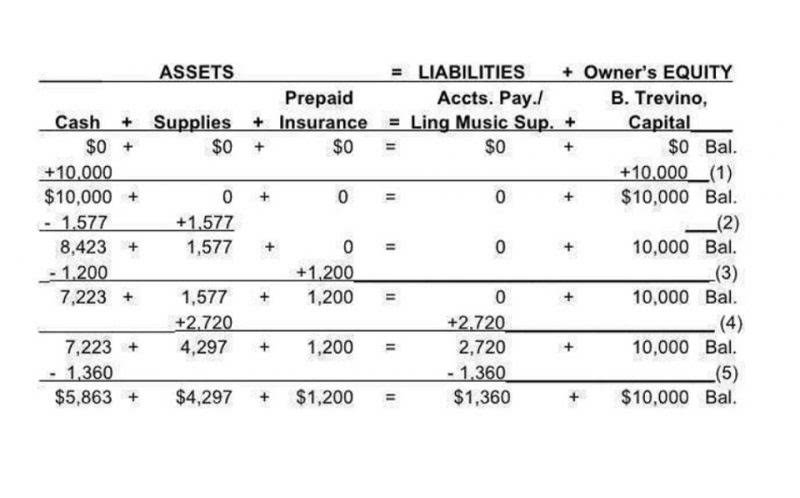For example, if an individual invests $20,000 in the company but also brings in a $10,000 liability, their initial Capital is $10,000 (investment minus liability). After you enter the opening balance, go to your account register and make sure it’s accurate. If your customers or vendors have outstanding balances from before your opening balance date, enter the individual unpaid invoices or bills. This creates open balances that collectively result in your Accounts Payable and Accounts Receivable opening balances.
What is Opening Balance Equity in QuickBooks?
Double Entry Bookkeeping is here to provide you with free online information to help you learn and understand bookkeeping and introductory accounting. Suppose the founder starts a new business with an opening share capital of 100. All this frees you up to spend your time on what really matters, your business! Get in touch today for a no-obligation, free demo to find out what Mooncard can do for you. Once the business is up and running, opening balance equity unforeseen events may also lead to bad debts having to be estimated and written off.
- She holds a Masters Degree in Professional Accounting from the University of New South Wales.
- A specific example of an opening journal entry is that of a new business formed by a founder purchasing shares for cash.
- Cash flows become more visible and forecasts can be made more easily on the basis of accurate facts and figures.
- Regular reconciliations and ongoing monitoring of your accounts will help maintain the accuracy of your records as your business evolves.
- We’re always available if you need more assistance managing your accounts in QuickBooks Online.
Clearing Equity via Retained Earnings in QuickBooks
Your opening balance equity will be used to enter in a unique account which you will only use once whenever you are setting up your business in QuickBooks. This is done after entering all of your other opening balances so that you can have exactly the right amount to balance your accounts. The amount of money whether positive or negative at the beginning of the accounting period refers to the opening balance of an account.
Transferring Opening Balance Equity to Retained Earnings:
You can have an opening balance for different types of accounts, like how much money you have in the bank (assets), what you owe to others (liabilities), or what your business is worth (equity). There also can be opening balances for your revenue and expense accounts. An opening balance is the amount in a financial account when a new period begins, like a new year or month (it also applies to when you set up a new company file in QuickBooks). It’s the starting point for keeping https://www.bookstime.com/bookkeeping-services/fresno track of money coming in and going out. In other words, it’s the first number you see when looking at your finances for a new period.
- For example, if an individual invests $20,000 in the company but also brings in a $10,000 liability, their initial Capital is $10,000 (investment minus liability).
- Auditors assess the valuation and completeness of these records, ensuring that the equity balance is reflective of the company’s true financial state at the point of transition.
- For the correct adjustment procedure, the ending balance should be entered, bank-cleared items should be marked, and then the balance should be reconciled to zero.
- Her areas of expertise include accounting system and enterprise resource planning implementations, as well as accounting business process improvement and workflow design.
- There also can be opening balances for your revenue and expense accounts.
- Make sure to have all the necessary information and documentation on hand to ensure accuracy and completeness in this process.

It’s essential to double-check the accuracy of the opening balance amounts and dates before saving them in QuickBooks. Any discrepancies can lead to discrepancies in your financial records and potentially cause issues when reconciling your bank accounts in the future. By entering the opening balances for your bank accounts, you are ensuring that your cash balances in QuickBooks match your actual bank balances.
Updating financial statements after the transfer:

These transactions could include the initial investment made by the owners, any loans taken out, or any profits or losses generated during the period. It is important to note that this account is temporary and should be closed out at the end of the period to ensure accurate financial reporting. When you https://www.facebook.com/BooksTimeInc/ start using QB you enter all values from your balance sheet and the difference between assets and liabilities as of your “open in QB” or any other accounting program, is your Opening Balance Equity. It shows the discrepancy between a firm’s assets and liabilities at the commencement of a new accounting period, such as the beginning of a new fiscal year or when a new company is formed. Opening Balance Equity is the offsetting input which is used by you while entering account balances into the QuickBooks accounting software. This account is required when setting up QuickBooks when there are existing account balances.

- The journal records the assets, liabilities and equity of the business in the general ledger as opening balances.
- QBO only allows the creation of a singular account under the Opening Balance Equity (OBE) account detail type.
- This account is required when setting up QuickBooks when there are existing account balances.
- It can be the initial quantity of inventory on hand or the value of the inventory at the moment of setup.
- Opening balance equity is the offsetting entry used when entering account balances into the Quickbooks accounting software.
- It should only ever be used, whenever you are establishing your business, and then it should be locked.
At the end of your first fiscal year,if not automatically moved, you would transfer that OBE from the beginning to your regular equity account. In QuickBooks, the opening balance equity account is known as a single-use account. It should only ever be used, whenever you are establishing your business, and then it should be locked. If the above conditions are right, then the Opening Balance Equity is anticipated to be the same as the Retained Earnings balance from the previous software of financials of the accountant.
Suppose a business has been in operation for a number of years and has decided to start operating a double entry bookkeeping system. In many cases, the business owner will invest funds into the company in order to set it up, either from their own savings, in the form of investments from “angel” investors or a loan from the bank. The concept of an “opening balance” is key to really getting to grips with the financial health of your business and setting the pace for the year ahead. If you need to add transactions that are older than the opening balance, you need to edit the start date and balance.
Asset, liability, and other types of accounts
From what I’ve gathered, the OBE account is for entering the balance of an account when it first connects with QuickBooks, but beyond that I’m lost. Someone before me did some journal entries in the OBE to get the balance to 0.00, but they put it into Undeposited Funds and now every time I make a bank deposit, the OBE balance is included with the checks. I just uncheck it to finalize the deposit, but is there a way to fix this? I’m trying to understand OBE so I can know the proper place for these journal entries because they aren’t making sense to me. Check the total sum once you enter all of your company’s opening balances in each account.

